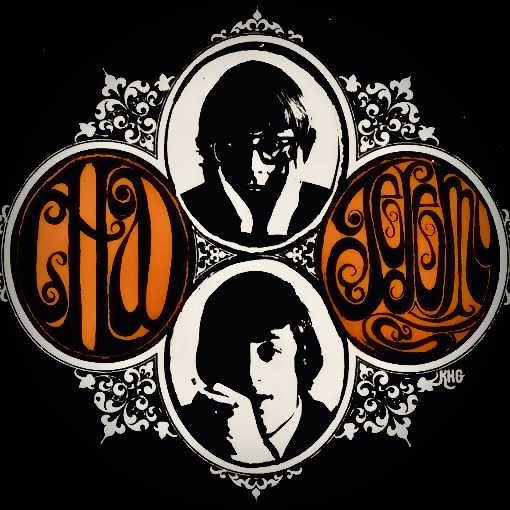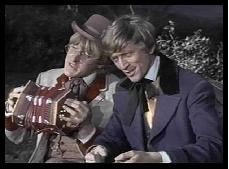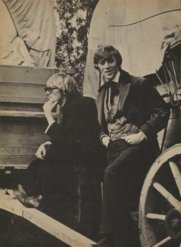Part Three: Fame II
1966-1968
By the fall of 1965, it seemed as if C&J may have gone their separate ways for good...but that didn't last long...
In late 1965, an opportunity presented itself that stood to possibly satisfy both Jeremy's desire to act and Chad's desire to record. The NBC network presented the duo with a concept for a new Chad & Jeremy TV show, spun off from their Western series, Laredo. In order to record the pilot, which would be broadcast as an episode of Laredo, Jeremy had to go to great lengths to negotiate a gap in his Passion Flower Hotel schedule. Jeremy remembers well his effort to get a few weeks off from the play. “It was a six-month run, with six weeks of rehearsals. I actually negotiated to get out of that to do the Laredo pilot, because it was so important.” Since Jeremy had made an extra effort to come to America to film the pilot, in return, Columbia and Chad went to extra effort to record some new tracks.
In November 1965, Columbia Records arranged for Chad to fly to London to record a follow-up LP to I Don't Want To Lose You Baby. Jeremy was still three months away from finishing his run in Passion Flower Hotel, necessitating Chad's overseas jaunt. Chad & Jeremy were in the studio again, much to the relief of their label, but the results of the session were mixed, including some great songs, and some strange selections. Tempting covers of “Love Is Strange” and “You've Got Your Troubles” were discarded, as were oddities like “Sixpence” and "Wonderful Land,” cover of a Shadows instrumental. At the end of the sessions, “Homeward Bound” and "Ballad of a Teenage Failure" became prime candidates for single release. In the end the record label inexplicably chose the latter, partly out of a desire to steer the duo in a harder direction, but with "Early Morning Rain" as the flip side to appease Chad & Jeremy 'purists.’
Jeremy recalls that the duo may not have had much choice in picking "Teenage Failure" over the Paul Simon track. After meeting Paul Simon at a Columbia Records launch party for Bob Dylan's Blonde on Blonde LP, Jeremy asked Paul to play him a few songs. He then proceeded to "sit on my sofa and play something like 18 classics one after another!" But by the time they were recording in November, "Sounds of Silence" was beginning to climb the US charts. "When we were recording in London," says Jeremy, "he came to watch us, and it was while we were doing 'Homeward Bound' that Tom Wilson at Columbia rang - and Paul said, 'bye bye boys, I'll see you in the charts!'" It was quite clear that "Homeward Bound" would be amongst the contenders for a follow-up to "Sound of Silence," and putting “Homeward Bound” out would be repeating the same situation that had sunk Chad & Jill's "The Cruel War."
This decision to go with Jeremy's rocker, rather than taking a chance with "Homeward Bound" or other tracks from those sessions would be much to everyone's regret when "Teenage Failure" fell straight to the bottom of the charts, while "Homeward Bound" could have been released instead, possibly pre-dating Simon and Garfunkel's version. Meanwhile, in late 1965, Jeremy's UK single of "I Love My Love," recorded to promote his appearance in the play, was released. Jeremy's single shared the same fate as Chad's "Cruel War," as Chad remembered, "It skyrocketed to oblivion in no time flat!" Jeremy doesn't even recall giving consent to release the single, as "it wasn't the sort of single I would have liked to release." The next time Jeremy issued a solo record, it would be under vastly different circumstances.
As 1966 dawned, the group seemed to the public to be as fractured as in the previous summer. But big plans were afoot - for a comeback record, an appearance of the nation's biggest pop music show, and a chance at their own TV series! In January 1966, after filming the TV pilot with Chad in America, Jeremy continued to work in the theatre while "Ballad of a Teenage Failure" was released (and promptly sank from sight).
About all Chad could remember doing in early 1966 was building a doghouse- things were a bit quiet, evidently! When Jeremy returned for good in late February of that year, their first "reunion" gig was at the San Remo Pop Festival in Italy, alongside such acts as The Yardbirds, Bobby Vinton, and Gene Pitney, with whom they would tour in the fall. Then the duo returned to TV in a big way, hosting an episode of Hullabaloo which featured them performing three songs: "Where Would You Be Without Me?", a hilarious Broadway style comedy number; "Distant Shores"; and "Sticks and Stones.” At the time, the November 1965 recordings were planned to be issued as an LP entitled Sticks & Stones & Things. As it turned out, “Sticks And Stones” would not be released until 2000, as "Distant Shores" was slated to be their 'comeback' single. Then it was time to go back on tour, something which they hadn't done as a part of a package since Chad had fallen ill with mononucleosis a year before. Between gigs, they spent their time soaking up the California sun. Jeremy spent quite a lot of time with his new prize possessions - sports cars! While in England, Jeremy had purchased "a long, lean, suave and utterly impractical XKE Jaguar,” and his taste in cars continued "on the rock star route" in '66. But with Columbia begging for product, it was also time to go into the studio for another new album, though this time things would be drastically different.
The previous two LPs had been recorded under the watchful eye of Lor Crane, a Columbia staff producer of the old school. By the time of the 1966 sessions, Crane was gone, replaced by Larry Marks, a younger, more sympathetic character. Unlike the previous sessions, Chad, an arranger by profession, was allowed to truly work on the backing of every single track. Most of the tracks from November 1965 were scrapped, with a few salvaged as LP tracks, including their version of "Homeward Bound." The chosen single was a song by C&J's bass player, James William Guercio, "Distant Shores.” Chad used their newfound artistic freedom to the utmost he possibly could, recording five different arrangements of the song in various tempos. The one you hear on the record is actually one of the fast ones!
After "Distant Shores,” the duo themselves wrote arguably their best song to date, entitled "You Are She.” Both of these tracks would end up minor hit singles in the second half of 1966, but they would be Chad & Jeremy's last.
After the release of the Distant Shores LP, touring and promoting continued. At this point their live line-up included Chad on lead guitar, Jeremy on rhythm, James William Guercio on bass, and a drummer named Dennis Faust, and they played a series of shows opening for the Beach Boys. They appeared twice on Batman, the hottest program on TV in 1966, but their TV career took a blow when it was decided that their Laredo spin-off would not go forward, a big disappointment for the duo. The plot was promising, concerning two British actors stranded in the old west and trying desperately to survive by their wits, but NBC, smelling success with their new Monday night show, The Monkees, thought that two competing recording groups promoted on the same network was one too many.
One of the main pressures of this period, as Jeremy recalls, was keeping up with the demand for new hits. "The basic problem was writing.... because if you don't write a lot, then you are going to find yourself, as we found ourselves back in the 60s, being constantly short of material and constantly people demanding product, and demanding hits.” The strain of writing new material, though a very real concern, was certainly not apparent in their next single - "You Are She.”
"You Are She" reached the eighty-seventh spot in the charts, coming hot on the heels of number thirty "Distant Shores.” Although 87 isn’t a great chart placing, outlook was bright, and radio play was heavy. But Chad in particular had tasted the freedom that an innovative and creative producer could bring, and he wanted more. The duo had well outgrown their roots, but as 1966 wore into 1967, they began to outgrow their traditional medium, the hit single. They wanted to record something more substantial as a statement of their coming of age. When Chad came in with "Rest In Peace,” a six minute enormously innovative and complicated response to the cost of dying in America (brought on by the movie, The Loved One, and a reading of Jessica Mitford's The American Way of Death), it was clear that there was no going back.
Columbia brought in Gary Usher, hot off of his revolutionary work with the Byrds, to create a similarly revolutionary Chad and Jeremy LP. The recording sessions that became Of Cabbages and Kings stretched from late '66 all the way through the summer of '67 and it featured such innovations as the Oz Firesign Theater on side two. In September of that year, Jeremy explained some of the innovations found within "The Progress Suite:” “We have used everything that can possibly be used on a record in ‘Progress.’ We wanted to make a film, but we couldn't afford it, so we made a soundtrack without the film.”
Though it was artistically freeing to not worry about the pressures of hit singles and work on creating a piece of art, allowing the recording process to last for so long without any stop gap single would be C&J's massive miscalculation. So drastically did the music scene change from the time of their last record release, that not only did they alienate their original fan base, but also managed to sound as if they were simply trying to catch up to the Beatles. The duo acknowledged this even as the LP was released, Chad telling a New York radio station that "it had been almost six months since we had a record released and naturally, Columbia Records weren't too happy with the way things were going. We went into a sort of semi-retirement. At this time last year, we were musically bankrupt, but we know where we're going now!"
When the LP was released in September of 1967, the reviews were excellent, though some thought the duo had gone a little too far with their "Rock Suite in Five Fantastic Movements,” as the ads trumpeted. Columbia, desperate to recoup the large amount of money thrown into the project, spent a great deal more promoting it, only to see sales stall well before they had reached expectations. Although it was their artistic rebirth, Of Cabbages and Kings marked the beginning of the end for C&J commercially. Shortly after the LP was released, Jeremy took a role in Peter Shaffer's Black Comedy, which hit the stage in late 1967.
At this time, C&J were still touring, but long gone were the days of a few songs sung to rabid teenage girls in package tours. Now they made the rounds of the colleges, playing a two-hour show, at one point including Jim Gordon on drums, and featuring a horn section.
By the end of 1967, Chad & Jeremy had become favorites of Gary Usher, enabling them to convince him to go for more elaborate and expensive recordings than Columbia was willing to make. The first of these more elaborate works was a single, "Painted Dayglow Smile,” released to absolutely no airplay outside of NYC in November 1967. As 1968 dawned, they embarked on a new LP project. C&J's new project was another album which would mark a progression to one of clever psychedelic satirists. Where Of Cabbages and Kings had been chock full of in-your-face social commentary, this new batch of songs was much more subtle and, more importantly for Columbia, of much more manageable lengths! But because C&J were taking such a long time with their new LP, Columbia requested another new single.
Whether "Sister Marie" was ever destined to be included on The Ark, as this next single came to be known, is a bit of a guess, but after its release to almost universal apathy in early 1968, it seems to have disappeared from the running for the new LP. Interestingly, it was originally intended for Gary Usher's 'fake' group, Sagitarius, but after the duo rejected the track "My World Fell Down,” (a later hit for Usher's studio-group), they compromised and recorded a version of "Sister Marie.”
There are several remarkable aspects to The Ark. One is Charles Bragg's painting which graced the cover. Another was Chad's arrangements, but perhaps most noticeable is Jeremy's emergence as a songwriter. His quirky and original material constituted the bulk of the album. Mysteriously, after The Ark, he turned his back on lyric writing, and most of his subsequent songs were written with lyricist Dave Pierce.
As more and more songs began to be recorded for the new project, the bills began mounting. Columbia could see the situation in the studio getting out of control financially, and alerted Gary Usher to that fact. To Usher's credit, he ignored them, continuing work on The Ark without really inhibiting Chad's visions of grand production.
The true irony of this situation is that The Ark could have been recorded at a fraction of the cost at any small independent studio, but all Columbia contracts stipulated that their acts had to use the label's own studios at the prohibitive cost of the equivalent of $285.00 per hour! Even more ironic is that these studio fees were going back into Columbia's pocket, so in hindsight, it's hard to see what all the fuss was about.
Around this time, the group had almost completely split up, save for recording dates and occasional shows. Jeremy featured in Black Comedy, as well as doing an episode of My Three Sons during this period. Unfortunately, he sometimes missed concerts because of acting conflicts and tensions between the two began to mount.
During this period, Chad was approached to write the score for an American International Picture, entitled Three In The Attic. Bob Irwin once described it as "a very sixties movie.” For decades, Chad squirmed at the very mention of the film, the only explanation for his involvement being that, "I was so hungry to score a picture, that I deliberately clouded my judgement, and ignored that little voice inside me.” More than 50 years later, this evaluation is spot on. The movie is horrid, but the music is wonderful. Quentin Tarantino must have agreed – he used “Paxton Quigley’s Had The Course” in 2019’s hit film Once Upon A Time In Hollywood, and posters for Three In The Attic are seen throughout the movie.
Why "Paxton Quigley's Had The Course"? This was the original title to Three In The Attic, and as such, Chad asked Jeremy if he could write a song with that title. Undaunted by the impossible task, Jeremy brought what he’d written to Chad, who added his own section, and suddenly a cult classic psychedelic song was ready to go. It stood as Chad & Jeremy's last real songwriting collaboration. The song was saved from the film project, at least temporarily, so that it could be recorded at Columbia, instead of at Mike Curb's notoriously technically challenged Sidewalk Studios, where film work was being done. It was quickly added to the growing number of masters at Columbia and The Ark was ready to be released.
By now, Columbia could see the writing on the wall. The duo was in the process of splitting up, hadn’t toured since the spring, and they had just produced an enormously expensive record with no guarantee of a hit. From a business point of view, matters were simple. Gary Usher was fired for violating Columbia's directive to cut costs, and the LP was released with virtually no promotion behind it. This is one of the true tragedies of the Chad & Jeremy story, as what became their last album really could have been their first. The group, particularly Chad, had truly learned how to make the most of the studio environment, while their writing talents had reached an all time peak. With a bit of push behind it, The Ark could have been a real breakthrough, but Columbia simply didn't care anymore. Though Chad's continuing work on Three In The Attic would be released on Sidewalk Records under the moniker of Chad & Jeremy in 1969, the sad reality was that, by the end of 1968, Chad and Jeremy were no more.









